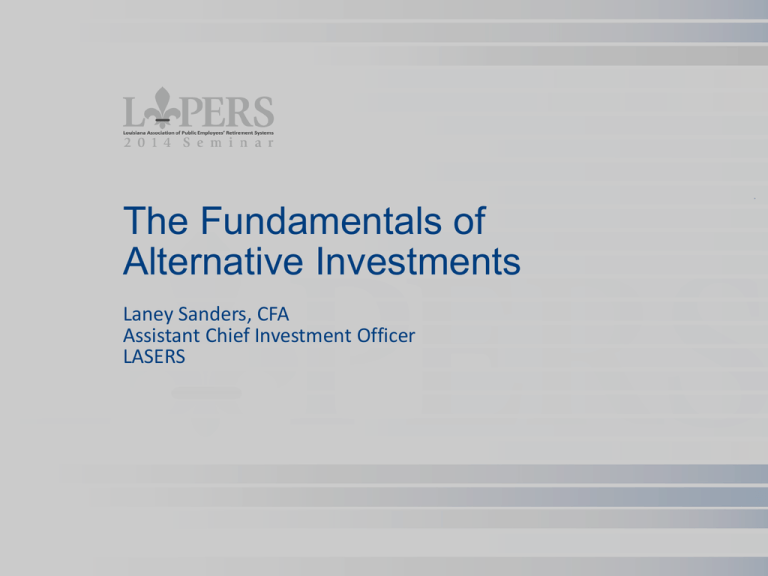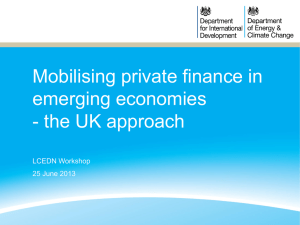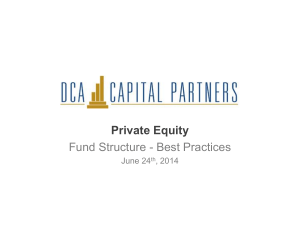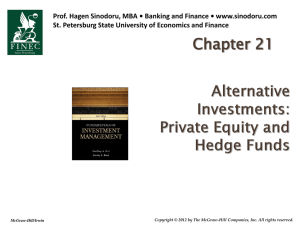The Fundamentals of Alternative Investments by Laney Sanders, CFA
advertisement

The Fundamentals of Alternative Investments Laney Sanders, CFA Assistant Chief Investment Officer LASERS 2 Topics 1. 2. 3. 4. 5. 6. Alternative vs Traditional Investments Types of Alternative Investments More On: Alternative Investments Fund of Funds vs Direct Funds Alternative Manager Selection Goals of Alternative Investing 3 Alternative Assets vs Traditional Assets What is a traditional asset? Include long positions in cash, bonds, and stocks. These are the most well known and widely used by investors. What is an alternative asset? A “non-traditional” asset. Encompass many different categories including: 1. Real Assets 2. Hedge Funds 3. Commodities 4. Private Equity 4 Types of Alternative Assets: Real Assets Real assets are investments that directly control nonfinancial assets and represent actual rights to consumption rather than indirect financial claims on cash flows generated by the tangible assets of a firm • A typical “financial asset” such as a bond, is a claim on a set of cash flows of a firm • Whereas a real asset is the investment in an actual physical asset such as: • Real Estate: land and permanent improvements to the land • Timberland: trees (underlying land is not always part of the investment) • Infrastructure: toll roads, utility companies, etc. Claim on the cash flow generated by these assets. • Intellectual Property: copyrights, patents, trademarks, royalties, etc. 5 Types of Alternative Assets: Hedge Funds Hedge Funds are private investment vehicles that capitalize on various investment opportunities. Funds often use derivatives, leverage, short positions, and other strategies. • Classifications of hedge funds include: • Futures Funds: Macro and managed • Event Driven: Activist, Merger Arbitrage, Distressed, Event Driven Multi Strategy • Relative Value Hedge Funds: Convertible, Volatility, Fixed Income, Event Driven • Equity Hedge Funds: Long-Short, Market Neutral, Short Selling, 130/30 • Fund of Funds: Hedge fund manager chooses and invests in underlying hedge funds 6 Types of Alternative Assets: Commodities Commodities are standardized goods (metals, agriculture products, energy products, and building materials) delivered to markets by many producers in large quantities • Commodity investments can take the form of: • Ownership of the physical commodity • Forward or futures contracts • Securities of commodity producing firms • Exchange traded funds (ETFs) – these provide passive commodity price exposure 7 Types of Alternative Assets: Private Equity Private Equity includes debt and equity securities that are not publically traded • Greater risk than public counterparts – more likely to achieve greater returns • Willing to accept long term investment horizons and conduct extensive due diligence • 5 types: • Venture capital • Leveraged buyouts (LBOs) • Mezzanine financing • Distressed debt investing • Special situations/opportunistic 8 Return Characteristics of Alternatives Diversification • Many alternative products have low correlation to traditional assets • Allow reduced risk without significantly lowering return expectations Illiquidity • Illiquidity refers to securities with infrequent trading and/or low volume trading • Difficult to observe price and returns through trades • “Lumpy assets” are difficult to divide and can only be traded in certain quantities • Illiquidity premium 9 Return Characteristics of Alternatives Market Inefficiency • Efficiency in markets means all available information is incorporated into asset prices • Efficient market prices reflect highly competitive bidding process • Inefficiency indicates that prices are different than those expected from an efficient market • • Fewer participants, lower competition Excess returns can be generated due to market inefficiency 10 More on: Hedge Funds Primary Elements of Hedge Funds Regulatory Structure • Privately organized and generally unlisted • Not heavily regulated – exempt from Investment Company Act of 1940 – do not adhere to same filing and disclosure requirements and record keeping as mutual funds • Must meet certain standards to invest such as “qualified purchaser” – net worth greater than $5 million for individuals or $25 million for institutions Trading Structure • Private securities, real assets, derivatives, structured products, leverage, long/short Industry Growth • $500 billion in 2000 to $1.8 trillion in 2010 11 More on: Hedge Funds Compensation Structure • Performance-based incentive fees that attract elite managers • Management fee – collected on a quarterly, semi-annual, or annual basis • Collected regardless of performance (1% - 3%) • Performance fee – collected annually but only if fund is profitable (usually 20%) • • High water mark provision – incentive fee only paid if NAV is above previous NAV Hurdle rate – incentive fee only paid after fund exceeds a set threshold return 12 More on: Hedge Funds Benefits of Hedge Funds 13 More on: Hedge Funds Definitions • • • • • • • • Long Position – owning a security Short Position – selling a borrowed security (sell high, buy low) Derivative – instruments which derive their value from an underlying asset Alpha – value added or subtracted by a fund manager (above or below a benchmark) Beta – market driven performance Leverage – increasing exposure to markets by borrowing and/or using derivatives Absolute Return Fund – euphemism for a hedge fund/ these funds were supposed to deliver “absolute returns” no matter what state the markets were in Fund of Fund – a fund that aggregates investor money and invests in hedge funds as opposed to stocks, bonds, and other assets 14 More on: Hedge Funds Traditional Funds vs Hedge Funds 15 More on: Hedge Funds Transparency • Most managers do not want to share their positions • Provides the ability to evaluate and understand the manager’s process/strategy • Institutions have asked for more transparency over recent years • Information usefulness • Many HFs now report to 3rd party risk aggregators (Measurisk and RiskMetrics) 16 More on: Hedge Funds Liquidity • Usually a 6 month to 1 year initial lock up unless some event occurs (key man provision) • Redemptions can usually occur every quarter with a 60 – 90 day notice • Gates/Suspensions • Side pocket investments 17 More on: Hedge Funds Leverage • Employed by HFs to magnify gains, but magnifies losses as well • Funds can employ different types of leverage • • • Financial (borrowing) Use of derivatives Can these exposures be quantified and monitored? 18 More on: Hedge Funds Hedge Funds Strategies Market Directional Corporate Restructuring Convergence Trading Opportunistic Equity Long/Short Distressed Securities Fixed Income Arbitrage Global Macro Emerging Markets Merger Arbitrage Convertible Bond Arbitrage Fund of Funds Short Selling Event Driven Equity Market Neutral Multi-Strategy Activist Investing Regulation D Fixed Income Yield Alternative Relative Value Arbitrage 19 More on: Hedge Funds Equity Long/Short • Like long-only traditional equity managers, these HFs will go long on the stocks they like • Also go short • • • Stocks they do not like or An ETF (S&P 500) or An index future • These managers tend to maintain a net long position • Shortcut: buy the good, sell the bad 20 More on: Hedge Funds Arbitrage and Merger Arbitrage • • • • • • • Loose use of the word “arbitrage” by hedge fund managers • “The exploitation of security mispricing in such a way that risk-free economic profits may be earned” • 1 security, 2 exchanges example In HF world, this usually means the purchase and sale of similar investments (not a risk free exercise) Empirical evidence suggests that corporations tend to overpay for acquisitions The stock of the company being acquired will trade at a discount to the offering price (reflects the risk of the deal not taking place) Merger Arbitrage managers will short the stock of the acquirer and buy the stock of the company being targeted Spread must be sufficient to compensate for the possibility of deal failing Shortcut: Short the acquirer, buy the target 21 More on: Hedge Funds Global Macro • Macro-economic approach/Global reach • These managers invest opportunistically across currencies, commodities, equities, fixed income, derivatives, etc. in any country or market • Use other strategies under their umbrella (fixed income arbitrage, equity long/short, etc.) 22 More on: Hedge Funds Multi-Strategy • Ability to invest in different strategies • Ability to shift capital across strategies to reflect their views on markets • Sometimes these funds will grow based on their “bread and butter” and then branch into other strategies • Use other strategies under their umbrella 23 More on: Hedge Funds Fund of Funds • Hedge fund managers that invest their capital into other hedge fund managers • Tactically allocate capital • Pros: • • • Immediate hedge fund diversification Fund of Funds (FoF) have infrastructure and expertise to conduct due diligence and monitor underlying managers Knowledge transfer to staff • Cons: • • • Double layer of fees (investors pay underlying hedge fund fee and FoF manager fee) could be substantial Asset allocation in the hands of the FoF manager Over-diversification is possible 24 More on: Hedge Funds The Good and the Bad The Good • Potential for non-correlated returns to traditional assets • Potential to reduce overall portfolio volatility • Access to the best • Rapidly evolving • Incentive structure The Bad • Complicated • Lack of transparency • Difficult to evaluate • Infrequent liquidity • Expensive 25 More on: Private Equity What is Private Equity • Limited Partnership Agreement (LPA) – legal framework for partnership and terms and conditions of fund investments in companies that are not listed on a publicly-traded exchange. • Private markets are usually less efficient. • Exposure to carefully selected and efficiently structured companies with strong corporate governance and growth potential. • A fund is managed by a General Partner (GP) who invests on behalf of the Limited Partners (LPs) • Ten to twelve-year limited partnership • Commitment called over four to five years • Distributions typically begin by year three or four • Partnerships are terminated once all investments have been liquidated 26 More on: Private Equity Private Equity Structure Three levels 1. Private Equity Firms (Zeus Global Management) 2. Private Equity Funds (Zeus Buyout Fund IV) 3. Private Equity Portfolio Companies (Sanders Bake Shop) Partnership Structure • General Partner – money management firm • Limited Partners – institutions and wealthy individuals • Limited Partnership Agreement (LPA) – legal framework for partnership and terms and conditions of fund 27 More on: Private Equity Limited Partnership Agreement PE Firm (Zeus Global Management) Limited Partner PE Investor (Pension) Partnership Interests (distributions) Investment (capital calls) General Partner PE Firm Fund (Zeus IV) Equity Position Investment Portfolio Company (Bakery) Portfolio Company (Shoe Store) 28 More on: Private Equity Cash flow pattern of investing in private equity – Years 1-3 returns are negative, little income is generated, management fees are collected on committed (not invested) base, additionally there are some early investments which fail; – Years 3-5 returns flatten out and gradually turn positive as values are written up to reflect transactions and some income is received; – Years 5-10 returns spike as assets are sold and accumulated increases in value are reflected, and income is received as businesses become profitable; – All years combined leads to what has been termed the “J-Curve.” 29 More on: Private Equity Projected Cash Flows for a $10 Million Commitment The “J Curve” $15,000,000 $10,000,000 $5,000,000 $0 Year 1 Year 2 Year 3 Year 4 Year 5 Year 6 Year 7 Year 8 Year 9 Year 10 -$5,000,000 -$10,000,000 Drawdown Distribution Cumulative Net Cash Flow J Curve 30 More on: Private Equity Venture Capital, Growth Equity, Buyouts Investment Style Time Horizon to Liquidity IRR Range DPI Multiple Primary Return Drivers Description of Investment Strategy Main Sector Types Venture Capital Investments in early stage of companies with an innovative and or a disruptive business idea for a proprietary product or service. Investments are made in the early life of the company, seed stage, early stage and pre-revenue. Technology Communications Software Bio-tech Healthcare Clean Tech 8 – 12 years 10% - 15% 2.00x Capital Appreciation Growth Equity Provides expansion capital for small, growing businesses, that are generating cash flow and profits. Generally, these types of investments have minimal exposure to technology risk Diversified 5 – 7 years 15% - 20% 2.00x Capital Appreciation 5 – 7 years 15% - 20% 2.00x Current Income and Capital Appreciation Buyouts Investments in established companies that require capital to expand and or restructure Business Services Industrial Consumer Diversified Business Services Industrial Consumer 31 More on: Private Equity Mezzanine Investment Style Mezzanine Description of Investment Strategy Investment strategy involving subordinated debt, (the level of financing senior to equity and below senior debt). Investments are generally shorter in duration, loans are 3 – 5 years, returns, generated are primarily current income with a lesser emphasis on capital appreciation Capital supplied by mezzanine financing is used for various situations such as facilitating changes in ownership through leveraged buyouts or recapitalizations, financing acquisitions, or enabling growth Revenue and Royalty interests are a subset of mezzanine financing that targets intellectual property, license agreements and other similar property that has the ability to restrict the rights to commercialization. Main Sector Types Companies in a variety of industries that are backed by Private Equity Managers (Sponsored) Or Not backed by a Private Equity Manager (Sponsor-less) Venture backed technology and healthcare companies Time Horizon to Liquidity IRR Range DPI Multiple Corporate Finance 11% - 14% 1.50x 1 – 4 years Venture Lending 11% - 16% 1.60x Primary Return Drivers Current Income and Capital Appreciation Current Income and Capital Appreciation 1 – 3 years Current Income Royalty and Revenue Interests generally targets intellectual property and pharmaceuticals Royalty & Revenue Interests 1 – 4 years 12% - 16% 1.60x 32 More on: Private Equity Distressed, Secondaries Investment Style Distressed Description of Investment Strategy Investments in companies that have poorly organized capital structures or failing operations. Distressed strategies includes trading strategies, significant influence and control positions. Long and short positions are commonly used as a technique to lock in profit or reduce risk. Secondaries Private equity interests are generally purchased at a discount from valuation from motivated owners of private equity interests. The interests purchased are generally venture and buyout interests with limited exposure to unfunded capital commitments. The strategy also includes the purchase of direct interests in companies through the secondary market Main Sector Types Trading strategies, Investment instruments include publicly traded debt securities, private debt, trade claims, mortgage debt, common and preferred stock and commercial paper. Time Horizon to Liquidity IRR Range DPI Multiple Primary Return Drivers 3 – 4 years 13% - 17% 1.65x Capital Appreciation 2 – 3 years 14% - 22% 1.50x Capital Appreciation Significant influence and Control strategies involve companies with poorly organized capital structures, turnaround situations and bankrupt companies. Diversified Venture and Buyout investors’ interests with limited exposure to unfunded capital commitments. Direct interests in companies through the secondary market 33 More on: Private Equity Energy, Infrastructure, Timber, Agriculture Investment Style Time Horizon to Liquidity IRR Range DPI Multiple Primary Return Drivers Description of Investment Strategy Main Sector Types Energy Investments will include exploration & production, generation, storage, transmission, distribution, renewable energy sources, clean technologies, energy technologies and other likekind investments Up-Stream Mid-Stream Down-Stream Power Cleantech Renewables Energy efficiency 5 – 7 years 15% - 20% 2.00x Capital Appreciation, some income from production Infrastructure Investments in physical assets or companies that operate assets that provides essential services to society and typically exhibit one or more of the following qualities: monopolistic or quasimonopolistic, high barriers to entry, long term assets, regulatory or permitting constraints Infrastructure strategies may be classified into four broad categories: Transportation, Energy and Utilities, Communications, and Social Infrastructure 5-15 years 6% - 15% 1.75x Current Income and Capital Appreciation Timber Investment in producing timber properties for forest products Hardwoods Softwood Plantations Growth only 10-15 years 6%-12% 1.50x Current Income and Capital Appreciation Agriculture Ownership of properties leased to farm operators Row & Field Crops Permanent Crops 6-10 years 6%-12% 1.75x Current Income and Capital Appreciation 34 More on: Private Equity The Good and the Bad The Good • Precedent of 20% + annual returns over long horizon • Diversification resulting in improved risk and volatility characteristics • Imperfect correlation with other asset classes • Market inefficiency; transactions are negotiated The Bad • • • • High risk, particularly on an individual transaction basis Illiquidity Lack of transparency Valuations somewhat judgmental 35 More on: Private Equity 36 More on: Private Equity Lifecycle Fundraising (0 to 1.5 years) • • Private Equity Manager raises sufficient funds for the strategy Investors make capital commitments to the fund Investing (1-6 years) • Private Equity manager calls capital from investors to source investment opportunities and create value Harvesting (7-10 years) • • Private Equity Manager exits investments through IPOs and Mergers and Acquisitions Proceeds of the exits are distributed to the fund’s investors according to provisions in LPA Liquidating (10-12 years) • Private Equity Manager exits the few remaining investments in fund 37 More on: Private Equity Projected Cash Flows for a $10 million Commitment $15,000,000 $10,000,000 $5,000,000 $0 -$5,000,000 -$10,000,000 Yr 1 Yr 2 Drawdown Yr 3 Yr 4 Distribution Yr 5 Yr 6 Yr 7 Cumulative Net Cash Flow Yr 8 Yr 9 J Curve Yr 10 38 More on: Private Equity Management Fees • General Partner is compensated through fees and shares of profits • Annual fee based on committed capital – Venture Funds: 2 - 2.5% – Buyout Funds: 1.5 - 2% • Profit participation – Most often set at 20% of gains – Usually above a preferred return of 5 - 10% 39 More on: Real Assets General Definition • Tangible assets that have their own intrinsic worth based on utility • Assets whose intrinsic value is less eroded by inflation compared to paper assets – provide real returns over inflation • Examples Real Estate Energy Commodities Timber Infrastructure TIPS/Inflation Linked Bonds Natural Resource Equities REITS 40 More on: Real Assets Commodities Purchase the commodity outright • Shipping and Storage costs/logistics Commodity Linked Notes/ Exchange Traded Funds • CLNs: Debt instrument whose value at maturity will be a function of the value of an underlying commodity index • ETFs: Simple, but higher fees for commodity index exposure and added layer of complexity Natural resource companies • Stocks and bonds of the companies • Do you get pure exposure to the commodity? • Equity Market Risk 41 More on: Real Assets The Business Cycle and Stock, Bond and Commodity Prices Equities Falling Bonds Rising Commodities Rising Commodities Falling GDP Bonds Falling Equities Rising Commodities Bottom Time Source: CAIA Level I Text (Anson) 42 Fund of Funds vs Direct Investing • Many alternative investments are in a fund structure (hedge fund, private equity fund, etc.) • There are two general ways to implement an investment: • Direct Fund • Fund of Funds 43 Fund of Funds vs Direct Investing • A direct fund is when a pension system invests directly in an individual fund • Louisiana Retirement System invests in the Zeus IV Fund • Zeus IV Fund invests in individual companies • A fund of funds is when a pension system invests in a fund that in turn invests the capital in a group of different underlying funds • Louisiana Retirement invests in the Cronus I Fund • Cronus I fund invests in the following funds: • • • • Zeus IV Fund Poseidon III Fund Hades II Fund Hestia IV Fund 44 Alternative Manager Selection Key drivers • • • • • • • Strong reputation Established firm Stable investment team Relevant experience Demonstrated track record Thorough due diligence process Ability to accommodate client needs 45 Alternative Manager Selection Due Diligence Process 1. 2. 3. 4. 5. 6. 7. Structure of the fund Investment strategy review Performance review Risk assessment Administrative review Legal review Checking references 3 fundamental questions in order to understand a fund’s investment program: 1. 2. 3. What is the fund manager’s investment objectives? What is the fund manager’s investment process? What is the fund manager’s competitive advantage? 46 Goals of Alternative Investing • Higher returns • Higher risk • Illiquidity premium • Diversification • Structure program so that returns of alternatives are uncorrelated to traditional portfolio returns • Unique Opportunities • Alternative investments allow strategies that are often not available in traditional long only investments 47 Questions?








